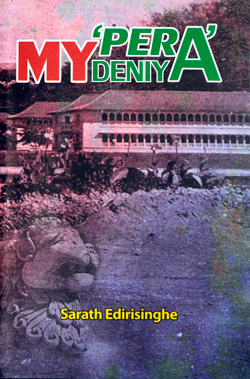An enthralling walk along the corridors of time
View(s): As someone who has spent the greater part of my working life in the General Hospital Kandy (GHK), this memoir ‘My Peradeniya’ by Prof. Sarath Edirisinghe is of particular interest. I was so enthralled that I could not put it down until I finished it!
As someone who has spent the greater part of my working life in the General Hospital Kandy (GHK), this memoir ‘My Peradeniya’ by Prof. Sarath Edirisinghe is of particular interest. I was so enthralled that I could not put it down until I finished it!
Professor Edirisinghe’s saga starts from his departure from his family home. His destination is the Peradeniya campus. He, together with his family leave in their Hillman, take the historic route through Hanwella, and Ruwanwella to Kandy.We are regaled with stories of battles fought, and old fortifications along the way. His destination is Marcus Fernando Hall, in the Peradeniya campus.
“The winding road going uphill reminded me of a path leading to an upcountry holiday resort. On the paved banks were pretty ferns with their coppery stems flowing across the stones between which water seeped. As we climbed, the breathtaking campus gleaming in the hot sun in the valley below opened up and within the next few minutes my brother took a sharp right turn that led to the picturesque Marcus Fernando Hall.”
There is a diversion to Kandy town, and an ensuing description of its mainly mundane buildings which I felt could have been omitted.
Those were the days when residence in one of the halls was looked forward to, not dreaded. The old colonial veneer still persisted with relatively sumptuous meals served in style.
The Duke of Edinburgh in his address at the opening ceremony of the university in April 1954 pithily describes the Peradeniya Campus “…Under the terms of the Kandyan Convention, Her Majesty is the successor of the King of Kandy who had the good sense to choose this site for a palace, and I also understand that one of your chronicles has described the river which passes the University Park as a ‘necklace of pearls around the neck of the queen of Kandy.’ You can pride yourself, therefore, that the past, the present and the poets approve the choice of this lovely site for the university.”
Professor Edirisinghe gives us a vivid description of his teachers, mainly the consultant staff and professors at the Kandy Hospital. This evoked nostalgic memories for me of friends, colleagues, even teachers.
The conversion of an estate to the picturesque Peradeniya campus is given in detail. A bibiliography would have been helpful.
His interesting account of his student days is followed by a description of his life on the campus after joining the Department of Parasitology in 1972, until his retirement as Emeritus Professor in 2007.
We read of the period of austerity in the 70’s during Mrs Bandaranaike’s regime, the shameful race riots of 1983; the terrifying time of ’88 and ’89, when his family and himself were victims.
This book is of immense interest, in particular to the doctors who walked the corridors of GHK, in the ’60s and ’70s, as students.
It is unfortunate that there are a few spelling and grammatical mistakes which could have easily been corrected.
Premini Amerasinghe


